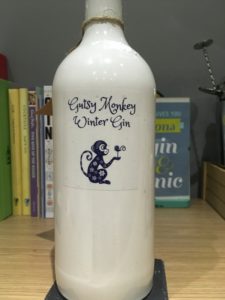 Heads up, this is another bottle that I adore. A ceramic bottle is massively underused (admittedly, it’s a cost thing) but Gutsy Monkey keep it simple and allow the bottle to draw you in. The team at Gin Kitchen have four spirits in their range: the Blushing Monkey uses black grapes to add a hint of pink to the gin; the Eternal Absinthe uses rose petals; and the Dancing Dragontail mixes aromatic green cardamom with pink grapefruit. Today however we are drinking their Winter Gin which mixes juniper with fresh lime zest, ginger and thyme, before adding some warmth from allspice, black pepper and cumin. Coming in at 48% ABV, I’m imaging this packs quite the punch.
Heads up, this is another bottle that I adore. A ceramic bottle is massively underused (admittedly, it’s a cost thing) but Gutsy Monkey keep it simple and allow the bottle to draw you in. The team at Gin Kitchen have four spirits in their range: the Blushing Monkey uses black grapes to add a hint of pink to the gin; the Eternal Absinthe uses rose petals; and the Dancing Dragontail mixes aromatic green cardamom with pink grapefruit. Today however we are drinking their Winter Gin which mixes juniper with fresh lime zest, ginger and thyme, before adding some warmth from allspice, black pepper and cumin. Coming in at 48% ABV, I’m imaging this packs quite the punch.
gin blog
Animus Macedon Gin
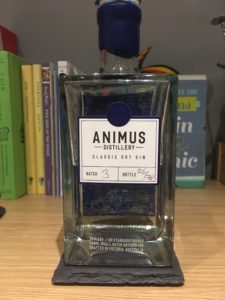 An Australian distillery founded by four friends – no it’s not Four Pillars, it’s Animus Distillery. Founded in 2015 in their garage, they soon expanded into their rural property in Central Victoria (about an hour from Melbourne). Their grain spirit is triple filtered through a custom made gravity-fed carbon filter before being vapour distilled – in fact many of their botanicals are grown on their farm. They are another brand with a big focus on sustainability, they reuse their botanicals as fertiliser and use recyclable materials in their packaging. They currently have four gins in their range: Abrosian gin with a South East Asian influences of mandarin, kaffir lime, galangal and ginger; Arboretum gin which utilises estate grown herbs lemon thyme, rosemary and native bush tomato; Davidsonia gin which is their take on a British sloe gin using a tropical sour plum with is steeped in their Macedon gin for a number of months. Speaking of the Macedon gin, that’s what we are trying today which is a London dry style using lemon myrtle and mountain pepper berry alongside juniper, cardamom, cloves, cinnamon, star anise and rosemary amongst many others.
An Australian distillery founded by four friends – no it’s not Four Pillars, it’s Animus Distillery. Founded in 2015 in their garage, they soon expanded into their rural property in Central Victoria (about an hour from Melbourne). Their grain spirit is triple filtered through a custom made gravity-fed carbon filter before being vapour distilled – in fact many of their botanicals are grown on their farm. They are another brand with a big focus on sustainability, they reuse their botanicals as fertiliser and use recyclable materials in their packaging. They currently have four gins in their range: Abrosian gin with a South East Asian influences of mandarin, kaffir lime, galangal and ginger; Arboretum gin which utilises estate grown herbs lemon thyme, rosemary and native bush tomato; Davidsonia gin which is their take on a British sloe gin using a tropical sour plum with is steeped in their Macedon gin for a number of months. Speaking of the Macedon gin, that’s what we are trying today which is a London dry style using lemon myrtle and mountain pepper berry alongside juniper, cardamom, cloves, cinnamon, star anise and rosemary amongst many others.
987 London Dry Gin
 987 gin is a Spanish London dry gin which goes through eight distillations. They macerate 14 botanicals including juniper, vanilla pods, thyme, bitter chamomile, lavender and mencia wine (a red grape with floral and red fruit flavours). These are combined with citrus fruits in copper pot stills with neutral grain spirit which was distilled five times, before being filtered and bottled by hand. They say the gin has heavy juniper and herbs on the nose, with the wine base bringing a combination of sweet and spice. The distillery also makes 987 Lollipop gin which uses cherries as their main flavour and their own premium red vermouth.
987 gin is a Spanish London dry gin which goes through eight distillations. They macerate 14 botanicals including juniper, vanilla pods, thyme, bitter chamomile, lavender and mencia wine (a red grape with floral and red fruit flavours). These are combined with citrus fruits in copper pot stills with neutral grain spirit which was distilled five times, before being filtered and bottled by hand. They say the gin has heavy juniper and herbs on the nose, with the wine base bringing a combination of sweet and spice. The distillery also makes 987 Lollipop gin which uses cherries as their main flavour and their own premium red vermouth.
Ägräs Gin
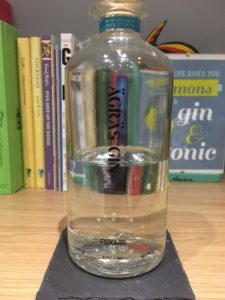 Today’s gin hails from Finland; the Ägräs gin distillery is in Fiskars Village, an old ironworks village 88km west of Helsinki. The distillery takes it’s name from the ancient Finnish god of vegetation, and they use just four botanicals (juniper, red clover, angelica and lemon peel) sourced from the forests of Finland. The distillery is the first crowdfunded distillery in Finland, with over 500 shareholders and now make their gin, an Akvavit, and the limited edition Abloom gin which takes their standard gin mixed with hibiscus flowers and honey.
Today’s gin hails from Finland; the Ägräs gin distillery is in Fiskars Village, an old ironworks village 88km west of Helsinki. The distillery takes it’s name from the ancient Finnish god of vegetation, and they use just four botanicals (juniper, red clover, angelica and lemon peel) sourced from the forests of Finland. The distillery is the first crowdfunded distillery in Finland, with over 500 shareholders and now make their gin, an Akvavit, and the limited edition Abloom gin which takes their standard gin mixed with hibiscus flowers and honey.
Avva Gin
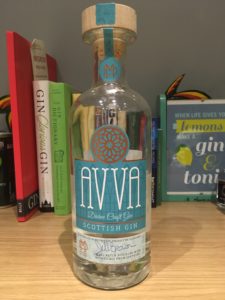 I’ve admired the bottle of Avva gin for a while, and truth be told it’s been sat on my shelf for nearly two years thanks to my old housemate bringing me a bottle home from one of her events. Based in the old cathedral city of Elgin (up the top near Lossiemouth) the Moray Distillery uses botanicals selected from the highlands and Speyside (including red clover, dandelion and nettle) to create their small batch gin. Avva means a respected grandmother from the Indian language of Dravidian, but in Hebrew it means to overturn or ruin – combined they make a nod to the traditional mother’s ruin reputation. Their still is made in Speyside and is named Jessie Jean after the founder’s grandmothers. The love of the local area continues into their branding, the label features the ‘rose window’ which is an idea of how the cathedral’s round window would have looked when it was still standing.
I’ve admired the bottle of Avva gin for a while, and truth be told it’s been sat on my shelf for nearly two years thanks to my old housemate bringing me a bottle home from one of her events. Based in the old cathedral city of Elgin (up the top near Lossiemouth) the Moray Distillery uses botanicals selected from the highlands and Speyside (including red clover, dandelion and nettle) to create their small batch gin. Avva means a respected grandmother from the Indian language of Dravidian, but in Hebrew it means to overturn or ruin – combined they make a nod to the traditional mother’s ruin reputation. Their still is made in Speyside and is named Jessie Jean after the founder’s grandmothers. The love of the local area continues into their branding, the label features the ‘rose window’ which is an idea of how the cathedral’s round window would have looked when it was still standing.
Fidra Gin
Note: I contacted Fidra to ask for a sample and a chat about where my family are from in Scotland, even though they’re based near the family home, I’ll tell you exactly what I think of the gin
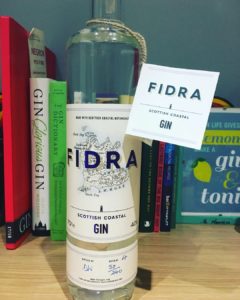 For those of you that know your Scottish islands, you might know of Fidra off of the coast of East Lothian. Fun fact – my Dad grew up near the border of East Lothian and we spent many a summer holiday eating ice cream on the beach in Musselburgh which is just along the coast. Emma and Jo set up Fidra Gin after their passion for gin developed and they wanted to showcase botanicals grown on the East Lothian coast. The botanicals used include sea buckthorn, elderflower, lemon thyme and rosehip, all handpicked from the local area. The proximity to the sea allows the botanicals to impart a slightly salty taste to the gin and their love for their area carries through to their branding, a beautiful tall, thin bottle with a label depicting the region. So, how does it taste?
For those of you that know your Scottish islands, you might know of Fidra off of the coast of East Lothian. Fun fact – my Dad grew up near the border of East Lothian and we spent many a summer holiday eating ice cream on the beach in Musselburgh which is just along the coast. Emma and Jo set up Fidra Gin after their passion for gin developed and they wanted to showcase botanicals grown on the East Lothian coast. The botanicals used include sea buckthorn, elderflower, lemon thyme and rosehip, all handpicked from the local area. The proximity to the sea allows the botanicals to impart a slightly salty taste to the gin and their love for their area carries through to their branding, a beautiful tall, thin bottle with a label depicting the region. So, how does it taste?
Biggar Gin
Note: I contacted Biggar for a sample and they kindly sent me one to try, as always I’ll let you know what I think.
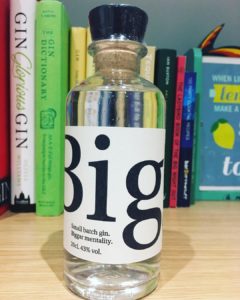 Biggar gin is one of the many new brands coming from Scotland, started by two brothers who focus on small scale production with big ambitions. They take their name from the town they grew up in, south of Glasgow and Edinburgh in the Southern Uplands and distil their gin at the famous Strathearn Distillery. Traditional botanicals juniper, coriander seeds, cardamom and orris root combine with rosehip, rowan berries and lavender. The idea behind the botanicals is to create a balance of flavours – sweet meets savoury, florals meet earthiness – which reflects the local landscape. So, how does it taste?
Biggar gin is one of the many new brands coming from Scotland, started by two brothers who focus on small scale production with big ambitions. They take their name from the town they grew up in, south of Glasgow and Edinburgh in the Southern Uplands and distil their gin at the famous Strathearn Distillery. Traditional botanicals juniper, coriander seeds, cardamom and orris root combine with rosehip, rowan berries and lavender. The idea behind the botanicals is to create a balance of flavours – sweet meets savoury, florals meet earthiness – which reflects the local landscape. So, how does it taste?
Edgerton Pink Gin
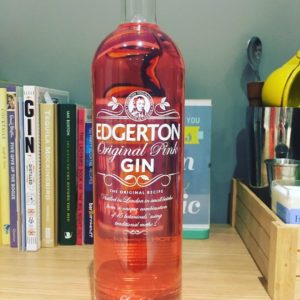 Next up in my series of “I have lovely friends that buy me gin” is Edgerton Pink gin courtesy of my lovely friends Tasj and Martyn. You look at a pink gin and instantly think of strawberries and raspberries, but interestingly the colour for this gin comes from pomegranate extract. They combine this with a classic juniper forward gin, citrus and spiced notes because they believe that colour is strongly linked to the success of the brand. Created by Martin Edgerton Gill and inspired by his father’s love of the Pink Gin cocktail after time spent in the Royal Navy, the traditional drink is gin combined with Angostura bitters to cure seasickness. Martin took this and twisted it using his knowledge of herbal teas to create a contemporary pink gin using fifteen different botanicals – including supposed aphrodisiac damiana leaves.
Next up in my series of “I have lovely friends that buy me gin” is Edgerton Pink gin courtesy of my lovely friends Tasj and Martyn. You look at a pink gin and instantly think of strawberries and raspberries, but interestingly the colour for this gin comes from pomegranate extract. They combine this with a classic juniper forward gin, citrus and spiced notes because they believe that colour is strongly linked to the success of the brand. Created by Martin Edgerton Gill and inspired by his father’s love of the Pink Gin cocktail after time spent in the Royal Navy, the traditional drink is gin combined with Angostura bitters to cure seasickness. Martin took this and twisted it using his knowledge of herbal teas to create a contemporary pink gin using fifteen different botanicals – including supposed aphrodisiac damiana leaves.
Six Bells Gin
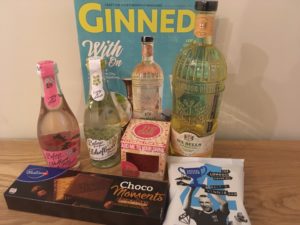 Happy Craft Gin Club delivery! And a big cheers to the first in my new home (spoiler alert: buying a house is stressful and expensive). This month’s delivery is yet another exclusive gin, courtesy of the City of London Distillery (which is about 50 feet from my day job just off of Fleet Street by the terrifying junction that is Ludgate Circus.). Alongside the gin, this month we were treated to two Belvoir pressés, a packet of Bahlsen crunchy hazelnut choco moment biscuits, some salt and vinegar London Crisps and a tub of popaballs. The City of London Distillery is so called because, surprise surprise, it is in the heart of the city; they opened their doors in December 2012 and have since gone from strength to strength, winning awards aplenty and now have five gins to their name (with Six Bells becoming their sixth). The focus of this gin is citrus. The usual gin botanicals of juniper, coriander, angelica root and liquorice root are joined by lemon rind, fresh grapefruit and sweet orange to create a big zesty mouthfeel.
Happy Craft Gin Club delivery! And a big cheers to the first in my new home (spoiler alert: buying a house is stressful and expensive). This month’s delivery is yet another exclusive gin, courtesy of the City of London Distillery (which is about 50 feet from my day job just off of Fleet Street by the terrifying junction that is Ludgate Circus.). Alongside the gin, this month we were treated to two Belvoir pressés, a packet of Bahlsen crunchy hazelnut choco moment biscuits, some salt and vinegar London Crisps and a tub of popaballs. The City of London Distillery is so called because, surprise surprise, it is in the heart of the city; they opened their doors in December 2012 and have since gone from strength to strength, winning awards aplenty and now have five gins to their name (with Six Bells becoming their sixth). The focus of this gin is citrus. The usual gin botanicals of juniper, coriander, angelica root and liquorice root are joined by lemon rind, fresh grapefruit and sweet orange to create a big zesty mouthfeel.
Pothecary Gin
Note: I met Lukasz from Pothecary gin at Junipalooza and he kindly sent me a bottle to try – as always, you’ll know if I don’t like it.
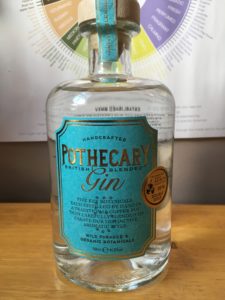 Pothecary gin was created because two friends share a passion for artisan – and organic – produce. This isn’t a London Dry style gin, they label theirs as “British blended” because they do things a bit differently over at Pothecary HQ. They distil each botanical separately and then blend these together before adding the water to lower the ABV. I’m not sure I’ve come across another gin that uses this method – gins that add flavours after the distillation certainly, but distilling each botanical on it’s own? Let me know if that is less unique than I think. Alongside the usual suspects of lemon peel (organic) and juniper (foraged) they use only three more botanicals – organic lavender and wild foraged tilia flowers and black mulberries (also organic). So how does this taste?
Pothecary gin was created because two friends share a passion for artisan – and organic – produce. This isn’t a London Dry style gin, they label theirs as “British blended” because they do things a bit differently over at Pothecary HQ. They distil each botanical separately and then blend these together before adding the water to lower the ABV. I’m not sure I’ve come across another gin that uses this method – gins that add flavours after the distillation certainly, but distilling each botanical on it’s own? Let me know if that is less unique than I think. Alongside the usual suspects of lemon peel (organic) and juniper (foraged) they use only three more botanicals – organic lavender and wild foraged tilia flowers and black mulberries (also organic). So how does this taste?